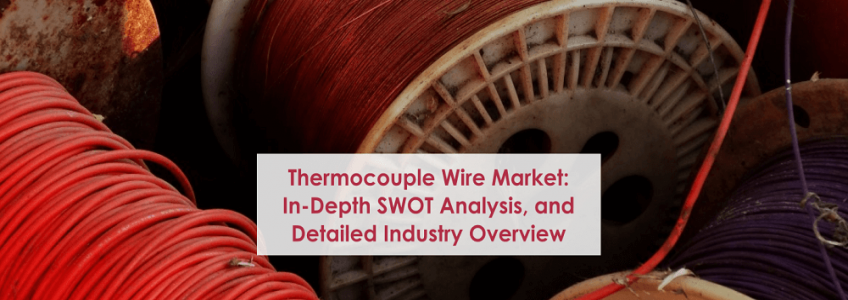Thermocouple Wire Market: In-Depth SWOT Analysis, and Detailed Industry Overview

Thermocouple wire is a type of temperature-sensing device used in a variety of industrial and commercial applications. It consists of two metals that are joined together to form a circuit. When a temperature difference is detected between the two ends of the circuit, a small voltage can be measured and used to determine the temperature.
The two most common types of thermocouple wire are Type K, and Type J. Type K is made from nickel-chromium and nickel-aluminum alloys, while Type J is made from iron and constantan. Each type of thermocouple wire is best suited for specific temperature ranges and environments. For example, Type K is often used in high-temperature applications, while Type J is used in lower temperatures.
One of the biggest advantages of thermocouple wire is its accuracy and reliability. When properly installed and maintained, it can provide accurate temperature readings over a wide range of temperatures and environments. Another advantage is its low cost, making it an affordable solution for many temperature-sensing applications.
1 . Applications of Thermocouple Wires
2 . Thermocouple Wires Market Forecast
- The global thermocouple wire market was valued at US$ 954.6 million in 2022 and is anticipated to reach US$ 1303.8 million by 2029, witnessing a CAGR of 4.5% during the forecast period 2023-2029. The influence of COVID-19 and the Russia-Ukraine War were considered while estimating market sizes.
- Asia-Pacific is the largest Thermocouple Wire market, with about 34% market share. North America is a follower, accounting for about 27% market share.
- The key players are TE Wire&Cable, Johnson Matthey, Heraeus, Sandvik (Kanthal), BASF, OMEGA Engineering, Belden, Pelican Wire, National Instruments, Indutrade (Pentronic), Pyromation, Dwyer Instruments, Tempco, Durex Industries, Marlin Manufacturing Corporation, Multi/Cable Corporation, Ellab, Temprel, Thermo-Electra, Hayashidenko, etc. The top 3 companies occupied about 13% market share.
Global Thermocouple Wire Market Research Report
3 . SWOT Analysis of Thermocouple Wires Market

Strength
- High accuracy and reliability in temperature sensing: The accuracy and reliability of thermocouple wire in temperature sensing is a strength for manufacturers, as it allows them to offer customers a solution that can provide accurate temperature readings. For example, in industrial processes where precise temperature control is essential, thermocouple wire can ensure that the process runs smoothly and consistently.
- Cost-effectiveness compared to other temperature sensing solutions: Thermocouple wire is relatively inexpensive compared to other temperature sensing solutions, making it a cost-effective option for customers. For example, in a small manufacturing facility, using thermocouple wire can help keep costs low while still providing accurate temperature readings.
- Versatility and compatibility with a wide range of temperature ranges and environments: The versatility of thermocouple wire in various temperature ranges and environments is a strength for manufacturers, as it allows them to cater to a wide range of customer needs. For example, thermocouple wire can be used in high and low-temperature environments, making it a versatile solution for temperature sensing.
Weaknesses
- Competition from alternative temperature sensing solutions: The presence of alternative temperature sensing solutions is a weakness for manufacturers, as it can reduce demand for thermocouple wire. For example, the rise of digital temperature sensors may reduce the demand for thermocouple wires in certain applications.
- Dependence on raw materials and metal prices: The dependence of thermocouple wire on raw materials and metal prices can increase manufacturing costs, making it a weakness for manufacturers. For example, a sudden increase in metal prices can increase the cost of manufacturing thermocouple wire, making it less attractive to customers.
- Stringent government regulations: Stringent government regulations regarding the use of thermocouple wire can be a weakness for manufacturers, as it can increase production costs and make it more difficult to sell thermocouple wire in certain regions. For example, regulations regarding the use of certain metals in the manufacturing process can increase costs and reduce the competitiveness of thermocouple wire.
Opportunities
- Growing demand for temperature sensing in various industries: The growing demand for temperature sensing is an opportunity for manufacturers, as it increases the potential customer base for thermocouple wire. For example, the growing demand for temperature sensing in the food and beverage industry can provide new opportunities for manufacturers.
- Increasing adoption of industrial automation and process control: The increasing adoption of industrial automation and process control is an opportunity for manufacturers, as it increases the demand for temperature-sensing solutions like thermocouple wire. For example, increasing automation in the manufacturing industry can provide new opportunities for manufacturers.
- Growing demand for high-temperature applications: The growing demand for high-temperature applications is an opportunity for manufacturers, as it increases the demand for thermocouple wire that can operate in high-temperature environments. For example, the growing demand for high-temperature applications in the aerospace industry can provide new opportunities for manufacturers.
Threats
- Competition from other manufacturers and low-cost alternatives: The presence of other manufacturers and low-cost alternatives is a threat to thermocouple wire manufacturers, as it can reduce demand for thermocouple wire. For example, the rise of low-cost temperature sensing solutions from Asian manufacturers can reduce the demand for thermocouple wire.
- Fluctuations in metal prices and raw material availability: Fluctuations in metal prices and raw material availability can affect manufacturing.
- Economic slowdown: During an economic slowdown, demand for wire products may decrease as construction and manufacturing activity slows down. This can lead to excess inventory and lower prices, reducing manufacturers' profit margins.









